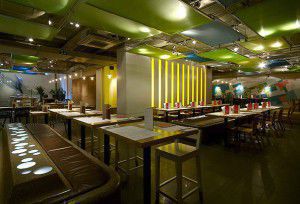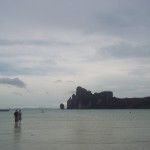A Lonely Planet?
Ask your grandparents where they went on their honeymoon and the vast majority will answer that they went to some seaside town within their own country. My grandparents for instance went to Scunthorpe, and by all accounts had a brilliant time. Now look at the destinations of the people who have recently been married around you, or those just heading away for a trendy city break or backpacking around the globe. Just in our office alone I am sure we can cover most of a world map with little flags signifying the countries we have visited. My point? The world appears to be shrinking and with it comes a certain amount of damage to areas of unprecedented beauty and to some of the many wonders of the world.
 In certain cases an increase in popularity or accessibility can lead to a few oddities, and fun, if unsympathetic activities. For example, in China at the UNESCO protected site of Mutianyu, what better way to place yourself in the shoes, or sandals, of the Mongol hordes than tobogganing down the side of the Great Wall of China? The same occurs at the site of the bridge over the river Kwai. The museum explains the history of the Burmese railroad, the numbers who died in its construction and the events portrayed in the 1957 film. You can then ride across the bridge on a traditional garishly rainbow coloured, road worthy train. Small gripes I know but are we not losing the significance of these sites by diluting them with fairground distractions? Or do these attractions simply add to the entertainment value of an area?
In certain cases an increase in popularity or accessibility can lead to a few oddities, and fun, if unsympathetic activities. For example, in China at the UNESCO protected site of Mutianyu, what better way to place yourself in the shoes, or sandals, of the Mongol hordes than tobogganing down the side of the Great Wall of China? The same occurs at the site of the bridge over the river Kwai. The museum explains the history of the Burmese railroad, the numbers who died in its construction and the events portrayed in the 1957 film. You can then ride across the bridge on a traditional garishly rainbow coloured, road worthy train. Small gripes I know but are we not losing the significance of these sites by diluting them with fairground distractions? Or do these attractions simply add to the entertainment value of an area?
In Thailand I also visited Koh Phi Phi, a small island chosen as the location of The Beach, a Leonardo Dicaprio film and book by Alex Garland, which portrayed a utopian island experience far away from the western confines of the mass backpacker route. 
Ironically the setting for this isolated paradise is now one of the most visited areas in Thailand and ’the Beach’ is now thronged with noisy tourists; the Andaman waters are now gleaming because of the residue left from the flotilla of tourist-packed speed boats that arrive at the location twice a day. Despite the numbers of tourists, ‘the Beach’ topped almost all guide books as a must-see, and whether I had been there was the first question fielded from friends at home. In the end it was simply a ticked box rather than a once in a lifetime experience.
What I am trying to determine from these small examples are the opinions of other tourists and travellers. I wanted to go somewhere because it was famous. People have heard of ‘the Beach’ and everyone knows about the Great Wall of China. But should the accessibility to these locations be limited? Is accessibility a good thing?
The example I want to finish on is Tibet. An area known by most people as a far outpost of China, an area little visited due to its isolation from, well, everywhere! It’s a spiritual area isolated from the western world, it takes two days by train to get there. With China planning a high-speed rail link to the area, how long will it be before you can toboggan from the top of Lhasa’s famous monastery?
Glyn
You look the same – you talk the same?
There is a never-ending stream of book-to-film adaptations. Those that quickly come to mind include The Shawshank Redemption, the Harry Potter series and the Twilight series.
One film that struck a chord is the 2005 film Memoirs of a Geisha. Based on the book of the same name by Arthur Golden, it depicts the tale of a young girl who grows up to be one of the most prominent geisha in Kyoto.
As a big fan of the book, I was curious as to how it was going to be made. However, I ended up being disappointed. I was confronted by a feature with three distinguished Chinese actresses in the lead roles, speaking English. The only Japanese native speakers had secondary roles, yet they were also speaking English.
From the initial news on its production, I envisioned the film to be a celebration of Japan – from its language to its culture. There was an opportunity to use undiscovered talent speaking Japanese, taking pride in a film about one of the most culturally significant aspects of their country.
The use of English may have increased the appeal and accessibility of the film but the fact that they used Chinese actresses to represent Japanese characters with English dialogue lacks originality. It is like a McDonalds film – it appeals to the masses with very little taste.
For this reason, I enjoyed Lost in Translation. You learn about different aspects of Japan – the culture, the country, the people – and most importantly, Japanese actors speak Japanese. So what if you do get lost in translation? That’s all part of the fun 🙂
So everyone, how do you feel about films with clashing cultures? Do culturally relevant films need English? Thoughts on a postcard (or in the comments!) please…
Katie
Mexican Wave
I don’t like shopping much – that’s just not me at all. But put me on the the A40 to Westfield, White City and I’m your man. Oh the joys of driving in post-riot Ealing at the end of last week! As I speed past spookily quiet streets complete with their boarded up shops and waved on by the police, I get there in record time. My one aim – to do my little bit for our economy during these dark days. I think the rest of West London has the same idea as the car park is filling quickly. But it’s the food that I’m after, for Westfield boasts a number of restaurants, and I’m in search of … well, what I’m told is the best Mexican in town.
Wahaca sounded like a bit of a godsend, if, like me, you’ve spent some time south of the Rio Grande, got to know the food, and returning home kept wondering why no one could be bothered to do it properly. That is until Thomasina Miers came along (ex-Masterchef winner, I’ll have you know) who set the joint up.

Thank you, Thomasina, for your unfussy, flavoursome delights that didn’t cost me ‘un brazo y una pierna’ (do they say that in Mexico?), for using fresh, well-sourced ingredients and keeping your food simple! I loved the Ceviche Salad – so fresh and lemony – and the Pibil Tacos, filled to the brim with tender marinated pork, weren’t bad at all. Oh, I could go on, because even if you think you don’t like Mexican food, there’s a chance you’ll change your views after eating here. Wash it all down with one of their Mojitos, or even a cerveza (you can get a Negra Modelo). Don’t go for a long, romantic dinner though – it’s too noisy and full of buzz!
Wahaca is a chain, but not on the scale of Topshop or Zara, just a few yards away; with just four premises they’re keeping it small, and I hope they don’t spoil it by opening too many more. You may not want to come all the way to Westfield – Soho and Covent Garden are central enough, if you’re visiting town.
Steve
Mysterious Albania
 Nestled in the heart of the Mediterranean with Greece, Macedonia, Kosovo and Montenegro as its neighbours, most people still don’t know much about this amazing country. Influenced by the Greeks, Romans, Italian and Turks, Albania does have a long and troubled history. But since communism ended in 1992 and the Republic of Albania was founded, it has remained more or less settled and it was chosen as the top country in the Lonely Planet list of ten top countries to visit for 2011.
Nestled in the heart of the Mediterranean with Greece, Macedonia, Kosovo and Montenegro as its neighbours, most people still don’t know much about this amazing country. Influenced by the Greeks, Romans, Italian and Turks, Albania does have a long and troubled history. But since communism ended in 1992 and the Republic of Albania was founded, it has remained more or less settled and it was chosen as the top country in the Lonely Planet list of ten top countries to visit for 2011.
To be honest, when I first met my Albanian husband Remzi, nearly five years ago, I did not know much about Albania myself – and I still meet people now who are not even sure where it is and think it is run by the Albanian Mafia! But I have now been fortunate enough to visit seven times, I’ve met all of Remzi’s family and friends and experienced the warm hospitality of the Albanian people and the beauty of the landscape. You also feel very safe; I remember on my first visit in September 2006, Albania were playing the Netherlands in a friendly football match in the capital Tirana and we happened to be walking past when the Dutch team’s coach got stuck on the turning into their hotel. The players decided to get out and walk – there were no police or security around and they just casually made their way to the hotel entrance. Cars on the main road did not even slow down; it was all very bizarre but typically Albanian – they do not like to make a fuss.
We have spent time in the mountainous North (where Remzi’s family are from) and the scenery is breathtaking, but I am yet to go to the beautiful and still unspoiled beaches in the South along the Ionian Coast, which is known as the Albanian Riviera. There are quite a few historic sites to see, like the ruins of Krujë Castle where General Skanderbeg fought off the Ottomans in the 15th century, and the many Byzantine churches and cobbled streets found at Berat Castle.
I have to admit I was quite slow off the mark in trying to learn the language, being a typical Brit and expecting everyone to speak English. The younger generation do but the majority of the population don’t, so it has been quite a struggle trying to communicate with most of Remzi’s family. But two years ago I started working at EuroTalk so had no excuse not to use the resources readily available to me! And it made a real difference on my last visit in June, which was just as well as we stayed with Remzi’s parents for most of the week. I have now decided to go to evening classes in the autumn where I hope to improve further and meet other people in the same situation as me with an Albanian partner. I find some words and phrases easy but just the basics like hello (‘tungjatjeta’) and goodbye (‘mirëupafshim’) are a bit tricky. So hopefully by my next trip I will have improved enough to have a proper conversation with my in-laws and get even more out of visiting such a wonderful country.
Do you have a partner from another country? How have you coped with learning their language?
Lotta





